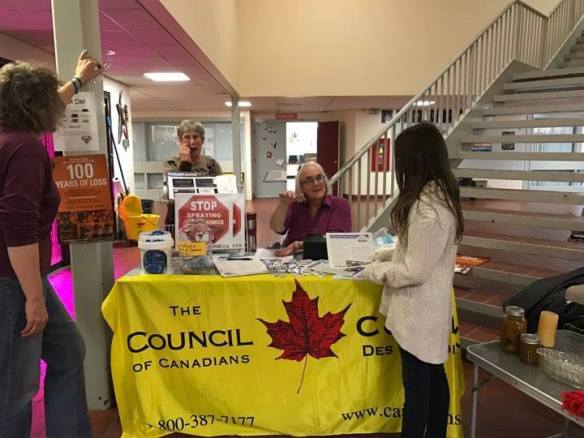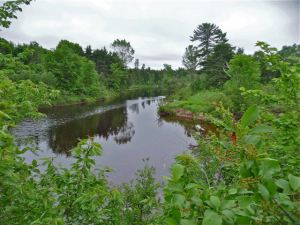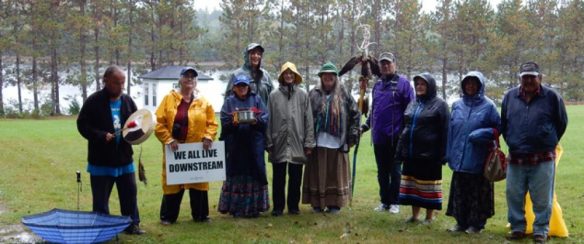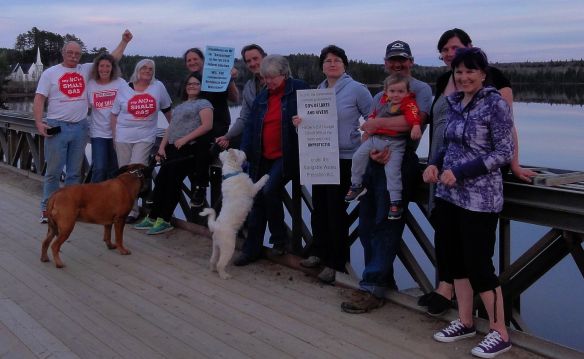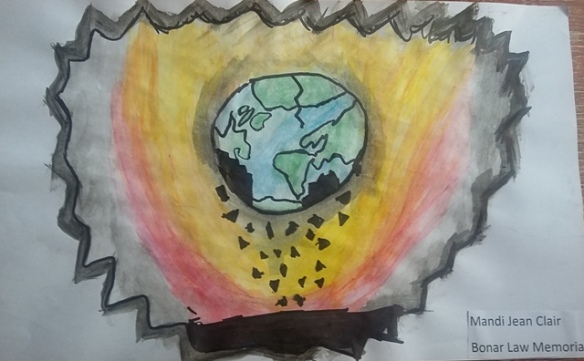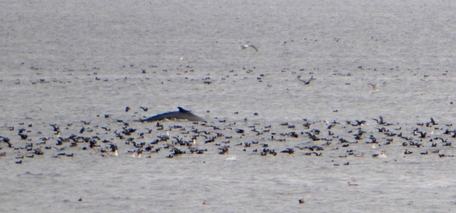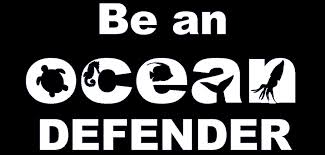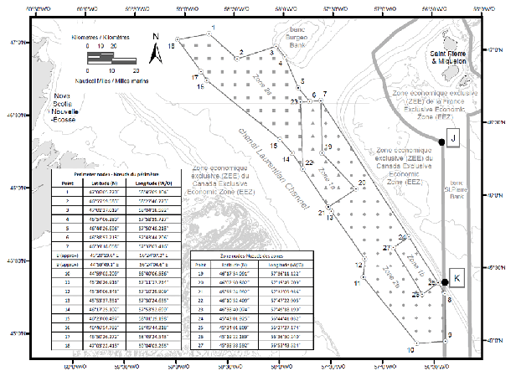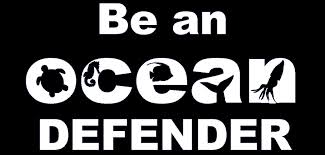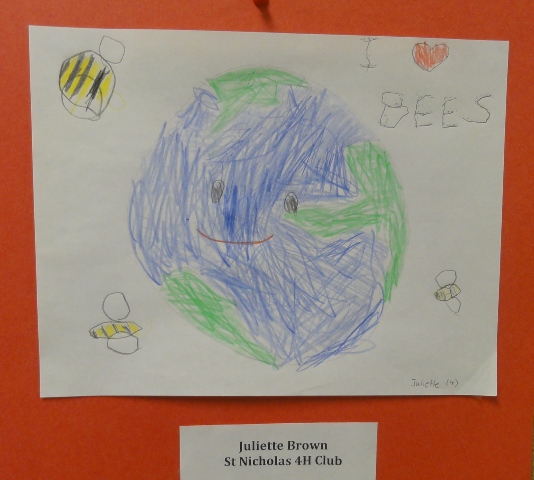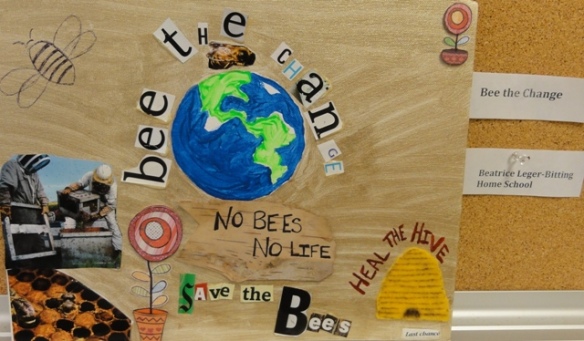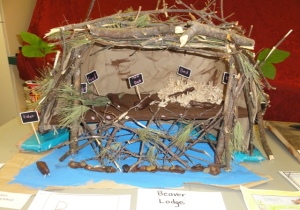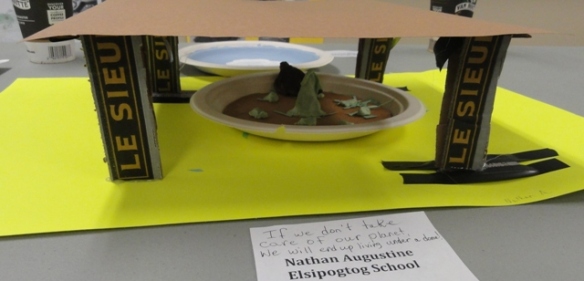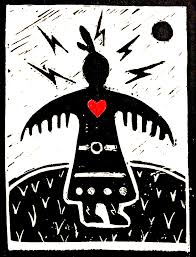The so-called dangerous RCMP “precedents” in Wet’suwet’en are actually standing operational policy.
by Ann Pohl, Part 2 of 2
The people in the photo above are the stragglers who were still around when we remembered to take a photo.
NOTE: Most photos in this blog are poor quality. Except where otherwise credited,
they are screenshots from this video OR this video.
Responding to the Call:
From the moment of the Wet’suwet’en call-out for international solidarity actions, we Sikniktuk water protectors knew we had to do something.
What the Wet’suwet’en were going through, on the opposite coast of Canada, was all too familiar to us. It is wrong. Both their territory and ours are unceded. In both cases the Indigenous People’s were saying “no” to the proposed industry on their lands. In both cases there are several Supreme Court of Canada decisions that specifically establish the rights of Indigenous people to protect the resources on these unceded territories. We both met unconscionable aggressiveness and disrespect from the RCMP. These are just of few of our similarities.
This solidarity message from Unist’ot’en meant a lot to us, back in 2013.
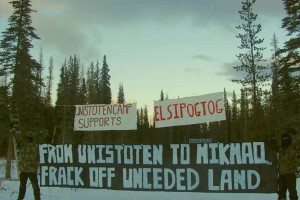
We faced the RCMP as corporate enforcers for the fracking company SWN Resources Canada everyday, for seven months, in Kent County NB/Sikiniktuk Mi’kma’ki, (aka “Rexton” or “Elsipogtog”). Things got especially rough in mid-October, which is when this message arrived.
In the first few weeks of our protracted defence of our water, back in June 2013, we met local RCMP on the frontline. Then we started seeing RCMP troops coming in from outside Sikniktuk. Here is a map of our Mi’kmaq district, from this Radio-Canada link). 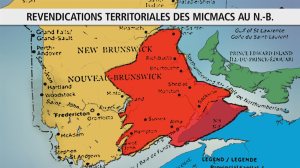
The local RCMP officers were back at the station. Scuttlebutt, aka “mocassion telegraph” or “grapevine news”, was that it was too hard for local RCMP to meet their extended family and neighbours on the frontline. The official line was they were needed for “regular duties.”
The imported RCMP troops chased us around for months. In mid-October, with days of precision planning including the apparent use of provocateur agents and infilitrators, the RCMP servants to the government of New Brunswick and SWN invaded our non-violent camp on Route 134 in Rexton. They said it was to enforce SWN’s corporate civil law injunction based on a SLAPP suit and extraordinary claims for damages.
Actually the RCMP invasion was all about rescuing the SWN “thumper” seismic testing truck that was being held behind a barricade by peaceful water protectors. The purpose of that equipment was to find the best place to start drilling, in order to frack for shale gas. Our primary strategy since June was non-violently resisting, by standing or sitting in front of the trucks, to stop the company from collecting this data.
When they invaded our camp on October 17, 2013, the RCMP imported 200 or so tactical and riot control RCMP. They came from at least four different divisions, if we go by their different outfits.
This slideshow requires JavaScript.
There were issues about RCMP conduct from the get-go. Based on these, the Civilian Commission mandated to review and report on RCMP complaints struck a Public Interest Investigation by the end of July. Complaints sky-rocketed after October 17th.
As the Commission’s investigation got underway, they met stalls and run-arounds, blank responses and inconsistencies. These raised more questions, and the Chairperson of the Civilian Commission filed his own complaint to the RCMP. “The December 17, 2014, Chair-initiated complaint will examine the conduct of those members who responded to, or managed the response to, the Kent County shale gas protests in 2013, including a policy and practice perspective,” says their website.
Countless people were “caught and released,” driven away from the protests and let go, sometimes in difficult circumstances. Over a hundred people in all were arrested. Some served jail time. Many were released on “conditions” that required them to stay away from protests, even our events and meetings. More than two dozen were actually named in the two SLAPP suits that formed the legal basis for the injunctions. Many of us SLAPPed had to countenance the threat of losing what we own, to make up for SWN’s so-called “damages” due to our resistance.
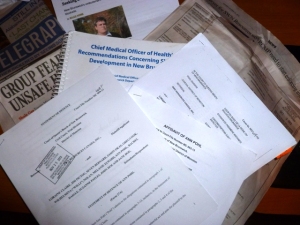
My SLAPP suit paperwork. 22 other people also got this.
None of us can forget how the RCMP acted and manipulated, the dehumanizing and viciousness. As the resistance built, the Indigenous water protectors led the way, and bore the real brunt of the resistance at the hands of the RCMP and the rest of the “justice” system.
For all of us, especially the Acadians and Anglo settlers in our unified movement, this was an eye-opener, about how the Corporatocracy of Canada operates. Those who still had some faith in our “democracy” (where politicians respond to grassroots peoples’ views) were deeply shaken in 2013.
In response to the call for action from Unist’ot’en last week, we immediately decided to gather mid-day on the road by the RCMP station in Richibucto. This station is closest to where the massive RCMP invasion of our water protection movement happened a little over five years ago.
Outside the RCMP station, January 8, 2019
While it was clear why, when and where we would rally in solidarity with the Wet’suwet’en People, what we would do was not. We did not expect many people. In this sparsely populated rural area, many people live close to the edge financially and do not have gas money to spare. The plan was for midday on a Tuesday. It was -20C outside. There was no way we could build a fire to stay warm in front of the cop shop!
But, the real reason we did not expect many people goes much deeper. To this day, many of our water protectors are still affected by the “state” coming down so heavy on them. To say our communities were traumatized and embittered by all of this is not an overstatement.

For starters, I had not notified the RCMP of our intent to gather at their station. So, there we were, in their parking lot with banners, signs and flags. I knew we had to go into the station and explain why we were outside. I expected no trouble with this. Though some newbies cycle through this RCMP detachment, the regulars at this station live and work in this area. These are our local guys. The ones we call for domestic, vehicle, theft, and other issues. It was their water and communities we were protecting, as well as our own. …In their hearts, they know this.
My worldview insists that inside everyone there is a conscience, though sometimes this is turned off by training, or by bitter experience. Above all, we had to try to communicate somehow with the RCMP so they could feel what their actions do to people. They must not be allowed to avoid understanding the consequences of their actions. This is the only way we can hope to rehumanize some of them, to reclaim them for the hard immediate work we have as a species, which is to change our behaviour, to save our single and only beloved shared planet.
I asked the first half dozen arrivals: who wanted to go in with me? All seemed willing. As the cleansing Smudge passed, I became fully aware that each of us had something important to say to the RCMP about why we were there. I proposed we all go in to do that.
We entered the RCMP detachment station in Richibucto, a large group, overfilling the waiting room lobby. (Eventually there were twenty of us.) I walked up to the recpetionist’s window and explained we were the people rallying outside with the signs and all, and we would like to speak with the most senior person in the station.
A few moments later, Cpl. Dan Melanson came into the lobby and introduced himself. I said we were gathered outside in solidarity with the non-violent Wet’suwet’en water protectors and land defenders, and presented him with the pre-invasion statement from their Clan Leaders.
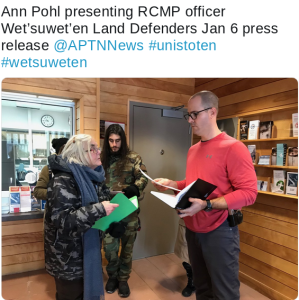
Wela’lin APTN reporter Angel Moore for being present and tweeting this photo.
He said that “over here in New Brunswick, we do not know too much about this issue.” I said his heavily militarized riot and tactical RCMP colleagues in British Columbia had just forcibly entered Wet’suwet’en unceded territory to enforce an corporate injunction. This news took many of us here in Kent County/Siknitktuk back to 2013, when we experienced the same thing. We had come to share what we feel about this.
We agreed to talk while standing in a circle in the lobby. I asked him to make notes of what we said, and pass these up the line of command., explaining we want to hear back from the leadership in the RCMP what they have to say about the points each of us would be making. He agreed to do that. Cpl. Melanson has since emailed me to say he has done as requested, and will get back to me when they get back to him. I am not holding my breath, but I do hope we will hear something back. Maybe even create an opportunity to speak with the regional commanders. Meanwhile I have asked Cpl. Melanson to send me the list of points he included in his internal memo. I have not yet heard back from him...

borrowed from Isaac Murdoch, chi miigwetch
As the early-birds among us entered the RCMP station, APTN reporter Angel Moore tweeted, “Protectors say people are passionate… Emotions are high, most of the protectors were here in 2013 at the anti fracking protests, and those who were not here remember.” Following is what we said to Cpl. Melanson…
Shame on Canada!
One of our group shared that “Criminal law is designed to control the poor, and corporate law is designed to protect the rich.” The RCMP are supposed to deal with criminals and public safety. Canada’s national police force has no business enforcing a private company’s interim injunction on unceded Indigenous territory. The RCMP knew this in early October 2013, but forgot it two weeks later. (For more on this and related points, see this critique I wrote about Bill C-51, especially point #3.)
In the case of the Wet’suwet’en People, there are clear legal reasons why it was wrong for the RCMP to invade their territory to push them out of the corporation’s way. Two Supreme Court of Canada decisions support the rights of the Traditional Clan Leaders to exercise jurisdiction over their original homelands, from “mountaintop to mountaintop” (the Tsilhqot’in Dcision), as recorded in traditional stories and songs passed down over the generations to hereditary leaders (the Delgamuukw Decision).
Talking with Cpl. Melanson, some of us observed that the current Canadian government, led by Prime Minister Justin Trudeau, consisently says it supports the United Nations Declaration of the Rights of Indigenous Peoples. (A CBC news report covered the spectacle Canada made at the UN plenary session in 2016, when it officially adopted the Declaration on the Rights of Indigenous Peoples.) The invasion of Wet’suwet’en territory on January 7th, and the continuing occupation of their territory by the RCMP, violates more than a dozen Articles of that Declaration, including Article 30 as the RCMP acted as a military force in this instance, and when here in Sikniktuk in 2013.
Another opinion offered to Cpl. Melanson is that The Indian Act Chief and Council have no jurisdiction beyond their reserve boundaries, so all the spin about how the RCMP are just enforcing “the  rule of law” is bogus. The tired old argument about the “rule of law” surfaces whenever politicians and police act on behalf of corporations to repress peaceful dissent. Clearly, the “rule of law” was on the side of the Wet’suwet’en (SCC decisions, limitations of The Indian Act politicians, UNDRIP).
rule of law” is bogus. The tired old argument about the “rule of law” surfaces whenever politicians and police act on behalf of corporations to repress peaceful dissent. Clearly, the “rule of law” was on the side of the Wet’suwet’en (SCC decisions, limitations of The Indian Act politicians, UNDRIP).
Dogwood says it clearly:
“Under The Indian Act, elected councillors only have jurisdiction over reserve lands – the tiny parcels set aside for First Nations communities that are administered much like municipalities. That’s not where this pipeline would go.
“What is at stake in the larger battle over Indigenous rights and title are the vast territories claimed by the Crown but never paid for, conquered or acquired by treaty. In Wet’suwet’en territory, those lands, lakes and rivers are stewarded by hereditary chiefs and their relatives under a governance system that predates the founding of Canada… History will not look kindly on politicians who condone the use of force against local people on behalf of a multinational oil and gas consortium.” (my emphasis)
Prime Minister Trudeau was quoted saying the use of RCMP was “less than ideal” but justified by the “rule of law.” Tanya Talaq tore strips off Trudeau, in the Toronto Star on January 10th:
“Let’s unpack that. A ‘less than ideal situation’ is missing the sale on three-ply Kleenex and having to settle for two-ply. A ‘less than ideal situation’ is locking your keys in your car. The arrests of 14 people by heavily armed RCMP officers over adherence to Indigenous human rights and land title? ‘Less than ideal’ doesn’t capture it. As this week again showed, the Trudeau government’s relations with Indigenous communities are nowhere near ideal.“
West Coast Environmental Law’s recent blog about the RCMP invasion of Wet’suwet’en Territory takes up the question of “the rule of law”
“Respecting the rule of law is indeed important, but it can’t be selective. To truly uphold the rule of law, the constitutional recognition of Aboriginal title and governance must be meaningfully applied in Crown decision-making, before crucial decisions are made about Indigenous territories… The Crown’s resistance to concluding agreements that meaningfully recognize title and rights, while making important decisions unilaterally in the meantime… is clearly incompatible with commitments at the federal and provincial levels to rights recognition and reconciliation.”
According to the Prince George Daily News, the RCMP are now planning to set up a temporary detachment in the area at the centre of this controversy. If feelings are running high, as they did here in 2013, this could lead to whole new crisis.
In fact, the rule of natural law that underlies all of the resistance. That is why the Wet’suwet’en want no pipelines on their territory, why we refuse to allow fracking shale gas here in Sikniktuk, and substantially what motivated each of us to be present in the Richibucto RCMP detachment last week.

There are huge social issues around our planet. Most are connected to the looming environmental collapse due to climate issues. Climate scientists’ international organization, the IPCC, recently released a report that says we have 12 years to limit climate catastrophe. 6,000 peer reviewed works are referenced in their report. “At the current level of commitments, the world is on course for a disastrous 3C of warming,” perhaps even more. (With our tarsands, melting icecaps, thawing muskeg, leaky pipelines and transportation systems, massive frack fields and hydro dams, monoculture tree plantations, 3 coasts of rising seas, abuse of salt waters, mega-agriculture, etc., Canada has a huge role in causation and vulnerability to disasters.) Even though change is slow, and many appear deaf to the facts, the IPCC report authors believe that “the increasingly visible damage caused by climate change will shift opinion their way.” Here in Kent County/Sikniktuk, we are already seeing the chaos and damage, and this is intensifying.

A young man from Saint John addressed this with Cpl. Melanson in a passionate intervention. Over the next dozen years or so, an extraordinary amount of damage will continue to be wrought on our planet. When it finally sinks in that Indigenous Peoples and non-Indigenous environmentalists are correct about the urgency of changing course to address climate change, “You and fellow officers in the RCMP will realize that you made a huge mistake helping to force through all this fossil fuel industrial development and infrastructure. You will come and want to join us then. Of course, we will welcome you. But the question individual officers need to ask themselves now, before it gets to that point, is ‘Which side of the history we are making right now do you want to be recorded as being on?’ “
Shame on the RCMP!
One person of blended settler and Anishinaabe heritage, but living in Kent County, said he goes into schools ls to teach children about culture and worldview. “The first of the seven sacred Grandfather teachings is respect. How can we respect the RCMP when they don’t even respect the people they are sworn to serve? With the children, I have no choice except to speak the truth, that we obviously can see with our own eyes. Who do they serve? Why do they disrespect the First People of Turtle Island, with their actions? These questions must be answered so we can have confidence in those that are here, supposedly, to protect and serve all of us.”
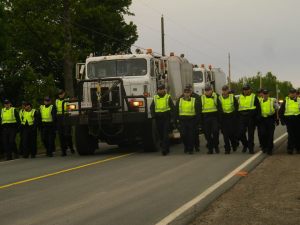
To serve corporations and protect their assets.
This man also mentioned community relationships. “Do you know the history of this region? Do you realize that your Acadian ancestors were helped to survive by the Mi’kmaq people in the 1700’s in particular? How could you justify what happened in 2013?” Someone else mentioned the Peace & Friendship Treaty, the only treaty ever signed by the Mi’kmaq. It talks only about how nations of Peoples should get along with one another, no mention of surrendering land, title, or guardianship.
Several people emphasized that we pay the salaries of the RCMP, who are meant to serve and protect everyone, not to serve and protect the corporations above all else.
At least three of those present had read the recently published book, Policing Indigenous Movements. A Mi’kmaq water protector said that it was “very disheartening” to learn the extent to which people like him are considered national security threats and what the state is doing based on that conviction. A non-Indigenous person said it was really embarassing that the RCMP had this attitude. Here is a link to an article, called Why the RCMP may not be a neutral player in the Wet’suwet’en anti-pipeline dispute, in which one of the scholars who wrote this book is interviewed. Cpl. Melanson was one of the people who wrote down the title of this book. Someone commented they hope he finds time to read it.
Mi’kmaq persons who were present at the RCMP invasion in our region in 2013 told Cpl. Melanson that many other people from Elsipogtog wanted to be there with us talking to him and rallying in support of the west coast water and land protectors. However, they were afraid to attend. Several commented that it was very good to have non-Indigenous allies present there with them.
Workers can refuse to work if the conditions are unsafe, so the question was raised, “Can the members of the RCMP refuse to work if they are being asked to do something they think is not ethical?” Cpl. Melanson seemed to find this profound, and perhapssad. The community membnr who raised this suggested that, given the serious deep environmental and climate issues humanity is facing, supporting pipeline infrastructure construction by oppressing non-violent defenders and protectors is unethical.

One of the grandmothers recounted a dream she just had. Her mother was dragged from her bed by an RCMP. She asked Cpl. Melanson, “When will the violence against us stop? Our ancestors are crying, our children are hurting, and I am not sure if you can do anything about it, but I really hope you can be a voice in someone’s ear.”
A non-Indigenous grandmother said that the world is in such a perilous situation environmentally that it is simply incomprehensible how the RCMP can justify to themselves that it is ok to promote further fossil fuel development. “It used to be that as a grandmother I would be thinking, should I start an savings plan to help with my grandchild’s education? Will they want to go to university? What will they do when they grow up? Now I think, will my grandchild have a planet on which to have a future?
Another grandmother said, “We are all concerned about future generations. The land doesn’t belong to the corporations, yet the RCMP protects them, while we pay your salaries with our taxes.”
A man commented that “we are tired of being bullied by you.” Another man followed this thread, saying we know what happened here in Rexton. The special RCMP who came here did what they are trained to do. It seems many come from families where you were brought up to hate, and went in all psyched up, to beat the crap out of Indigenous protectors. What you should have been doing is protecting the people who want to protect the water. It is your water too.”
 The observation was made that the RCMP are always in the middle of whatever brutal measures Canada is trying to force on Indigenous Peoples, and also have enough rotten apples in their own ranks that they are also mired in their own controversies about Indigenous Peoples. Cpl. Melanson assured us that the people he works with have good intentions and attitudes, but he said racism can crop up in any group. A community member said the RCMP must not allow themselves to be used in this way, and “to make your own definition of what is ethical behaviour.”
The observation was made that the RCMP are always in the middle of whatever brutal measures Canada is trying to force on Indigenous Peoples, and also have enough rotten apples in their own ranks that they are also mired in their own controversies about Indigenous Peoples. Cpl. Melanson assured us that the people he works with have good intentions and attitudes, but he said racism can crop up in any group. A community member said the RCMP must not allow themselves to be used in this way, and “to make your own definition of what is ethical behaviour.”
The topic of the Civilian Commission’s report came up. Here we are five and almost one-half years after the Public Interest Investigation was launched and we still have no report. Numerous news stories and reports coming from Wet’suwet’en describe that they are going through the same traumatic brutality and callousness we experienced, see: First Nations arrested at B.C. checkpoint accuse ‘over-equipped’ RCMP of excessive force, also: People arrested at Gidimt’en anti-pipeline camp allege inappropriate use of force. 
On January 14th, the New Brunswick Anti-Shale Gas Alliance issued an Open Letter to New Brunswick MP’s. They appear to have new information about the Civilian Commission report:
“The actions in question [in Wet’suwet’en] resonated strongly* with those of us in New Brunswick who experienced the similar action of the RCMP raid on Elsipogtog over five years ago… with government employing the RCMP as an enforcement arm of fossil fuel interests; elevating commercial interests via an injunction over the larger and fundamental issues of civil rights, indigenous rights and international obligations at play.
“We have two requests to make of you. The first is to make the federal government aware of our position and our support for the We’suwet’en Clan Leaders…
“The second request is for you and the federal government to put pressure on the RCMP Commissioner to release the CRCC investigation report on the events at Elsipogtog… It has been over 5 years in preparation, and via our communications with the CRCC we know that it has been completed and is only awaiting a decision to be released.” (my emphasis)
Hopes were expressed in front of Cpl. Melanson that we might see this report during our lifetimes. While it was felt that rank and file RCMP might be very interested to read and learn from this report,it was observed that sreluctance to allow this report to see the light of the day could well emanate from state security personnel (elected, uniformed, civilian) who believe their own hype that Indigenous rights activists, defenders and protectors are terrorists.
The report would almost certainly challenge the dominant narratives about who is wrongright as well as critique official justifications for use of extraordinary measures. The underlying question of whether the RCMP should enforce private corporate civil court injunctions will have to be addressed as well. n this report.
Another topic that was mentioned by several people was the RCMP protocol of excluding media. Here in Kent County/Sikniktuk it appeared almost accidental that the media could not get to the protest sites, where water protectors were preventing SWN Resources Canada from using their seismic testing equipment. A combination of RCMP tactics – ranging from kettling the protestors and protectors, to creating barricades so no cars could pass through, to using the draconian terms of the second injunction to prevent reporters from stopping anywhere near the SWN equipment – all served to create a media exclusion zone. As person who often did media liaison work, I frequently heard reporters complaining they could not get to our sites to cover the stories.
On the morning of the actual invasion, October 17, 2013, the only mainstream media that could enter the zone sealed off by the 200 or so militarized RCMP was the one reporter who came in with them, an “embedded” reporter from Sun News, who told only the RCMP side of the events. All alternative coverage came from social media, although early on the Halifax Media Co-op correspondent was able to send out some reports, until he was detained by police. A reporter from APTN found his way in at some point. Our area is not like the Wet’suwet’en Territory, in that there are multiple methods of access if one has the right vehicle, friends, and knowledge of the trails.
The outrage about this strategy being used in Wet’suwet’en is encouraging. When it happened here in Sikniktuk, it was hardly mentioned in amongst all the other concerns. Now we see the issue rising above the din.
The international Committee to Protect Journalists saying, “Authorities in Canada should immediately end the arbitrary restrictions on journalists covering the police breakup of the pipeline protest. Journalists should be able to freely cover events of national importance, without fear of arrest.” Apparently an RCMP spokesperson said the “temporary exclusion zone” was established to ensure public safety. It is worth noting that this is what RCMP commanders told me when I complained about the exclusion of media here in 2013. I argued that the presence of media would help ensure public safety, as we the public were the ones in danger from the company’s private security as well as those RCMP members with less self-control.
APTN reported that neither their news crew not the Vancouver CBC TV crew could enter, and NDP MP Nathan Cullen was also prohibited from accessing the site. As soon as the tactical/paramilitary RCMP force arrived on site, all social media feeds and posts are the Camp went silent. APTN also reports that an RCMP spokesperson said the police had nothing to do with the sudden, timely disruption of communications. However, Tom Henheffer, vice president of Canadian Journalists for Free Expression (CJFE), told APTN that this tactic “is very commonly employed and is very difficult to fight against… it takes too long for a journalist to get a lawyer, go to court to get an order to allow them to get on to the site.”
Ricochet media editorialized “We are gravely concerned by the RCMP’s decision to bar journalists from the site of yesterday’s raid, and their continued refusal to allow media access to the area today…. The right to freedom of the press is guaranteed in our constitution and the right of the public to know is fundamental to our democracy. …We note with concern that the department of public safety and the minister responsible for the RCMP, Ralph Goodale, have referred requests for comment to the RCMP, describing the exclusion of media as an “operational matter.” …this precedent must not be allowed to stand. It seems clear that the RCMP’s intent was to limit reporting from the site, rather than to safeguard the well-being of journalists. This is consistent with” an APTN report on “internal RCMP and government documents,” which “show ‘police are not assessing Indigenous protests in Canada based on factors of criminality but are more concerned about the protestors’ ability to gain public support.’ “
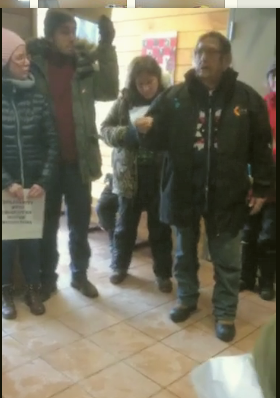
While we could argue that the “precedents” were set here in Sikniktuk, or least the mechanics tested here, on January 8th many of us raised the same points as the three organizations above.
An elder and community leader from Elsipogtog told Cpl. Melanson “Canada has abandoned you. Trudeau’s comments made that clear. He is saying the federal government has nothing to do this, like Pontius Pilate always washing his hands, always washing his hands. Trudeau might want to wash his hands but I will not allow him. This is going to fall hard on the RCMP. I very strongly condemn the invasion of a sovereign nation by the RCMP on behalf of Canada.”
“Look at us. We are not terrorists.”
In some ways, the time we spent in the Richibucto RCMP detachment lobby was like being in the opening round of a Restorative Justice Circle. Cpl. Melanson stood in for the entire RCMP force, as we shared our feelings from 2013 and strongly criticized the repeat operation that had taken place on Wet’suwet’en territory since the court appoved Coastal GasLink/TransCanada’s interim injunction.
One person who was present with us said, “What made it good for people was that RCMP Daniel seemed to truly listen and also that no one was rushed. Although we were in RCMP facilities, the lack of a desk between us made for a feeling of equality, as in a true, be it impromptu, round table discussion. …And afterwards, the warmth and sharing of the round dance, the Honour Song…..will stay in my heart, also, just so you know.”
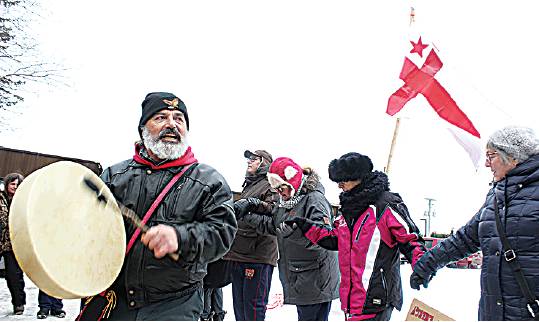
Credit to Ernesto Carranza, Miramichi Leader
Another person said, “They are trained to look like they are listening and to stay patient. I have a hard time trusting that anything improved will come from this, because all my life and in my work I have seen how they “act” with Aboriginal people.”
As much as we have trust issues with the RCMP, they have them with us. Another of our people commented, “Notice how he was standing with his back to the interview room and the door was cracked open? We did not have to ask him to take notes. In the interview room there is a camera and recorder of voice, and probably there is something like that in the lobby too.”
The reporter from the Miramichi Leader newspaper was perhaps more objective. He wrote, “Melanson stood in a corner and listened to protesters…” He quoted the Cpl. Saying, “I will relay these concerns up and for me that’s all I can do right now… We can take in the concerns of the community, actively listen, and see if those concerns make it to the right people.” The news story continued: Cpl. Melanson acknowledged he had “worked and lived in Richibucto for the last six years, was also in Rexton during the protests, and said he doesn’t want that situation to occur ever again.” (my emphasis)
In my view, committed as I stubbornly am to non-violence, the only way we can change things in human relationships is through changing understanding, through person-to-person conversation. What we did was important in general, but specifically for a community like ours which has been through exactly the same thing as happened in Wet’suwet’en territory last week.
For more than an hour, every time I looked at Cpl. Melanson, he looked very emotionally affected. Take a look at these images. You can also see more of him in the videos linked at the top of this blog, from which these still were taken.
What I saw each time I looked at him was he was often reflective and looking somewhat sad, or as if aching inside to be hearing all this. Down. At times his body seemed limp. Never angry. Sincere mostly. No doubt he must also have been frustrated by some recounts and comments that were harsh but he made no effort to argue. Only once did he try to correct (and that was me!). Perhaps he was even a bit grateful to finally have the chance to listen to us. As we were leaving, he shook my hand and said he was happy to have finally met me in person. I think there were others in the room he must have felt the same way about, as there were at least five others present who were centrally involved in organizing and speaking publicly in 2013. Odd that it took this long to start the conversation. That shows our lack of imagination as well as their limitations.
We are talking about doing something like this again. Personally, I am daydreaming about traveling across Canada, mobilizing local Indigenous-Settler alliances to go into cop-shops everywhere and try to get someone to sit down and talk with us. We have planet to save, and that starts with each of us.
A Final Word on “Reconciliation”
At the outset, I explained to Cpl Melanson we are here in solidarity with the Wet’suwet’en People because we know that they are going through. The APTN reporter who was present with us tweeted me saying, “What happened yesterday was illegal.” And also tweeted Melanson responding. “I will let my superiors know.”
A strong and committed water protector pointed out to Cpl. Melanson that after all that was done by the company and the government, much of which the RCMP had to get their hands dirty carrying out, “It did not work. There are ongoing community tensions, and really you ended up creating more resistance” because of the force’s appalling behaviour.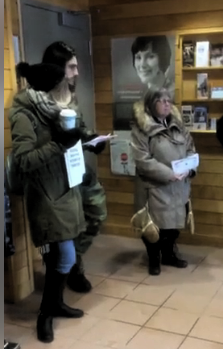
For me, I have been involved in citizen activism for peace and disarmament, anti-racism, civil rights, and international solidarity my entire adult life. In 1990, I was drawn into Indigenous human rights and solidarity work by the obvious injustices occurring at Oka/Kanehsatake. “Oka” was followed by the Old Man River, Ipperwash, Gustafsen Lake, Burnt Church, Elsipogtog, and now Wet’suwet’en. Personally I was only directly involved in solidarity work on a couple of these issues but I do know that the responses from the authorities to each of these have come from the same play book, albeit more sophisticated each iteration. It is no wonder to me that frustration is growing. Yes, of course, as my friend said, what the RCMP is doing is not working and it is only building more resistance and public support because it is so wrong.
Ellen Gabriel, always a respected speaker for the Kanehsatake Mohawks, commented on social media last week:
“We’ve been asked hundreds of times about lessons learned from the “1990 Oka Crisis.” Obviously Canada decided its lesson was to increase military training to its police forces.
“The “Kanehsatake Seige of 1990” included the status quo of Canada discriminating against the Haudenosaunee – People of the Longhouse – in fact making Indigenous traditional governments illegal. Canada deals only with the band councils it created and which it claims are the only ‘legitimate ‘ entity. So almost 29 years later people are now asking what is the difference between traditional governments and band councils.”
Gabriel’s answer is simple:
“One survived colonization. The other embraces it. The Two Row Wampum is the way to understand this. One path upholds Onkwehón:we culture, customs, law, and governance. The other path upholds the colonizers’ values and laws. There is no prejudice against those who chose the colonizer path, but allow those who choose traditional governance a voice and right to protect our ancestral heritage and human rights. Skén:nen.”
Few people realize Canada has signed many international human rights treaties and is required by some of these to report regularly to the UN Human Rights Committee on compliance issues inside Canada.
Even fewer people realize that Canada’s treatment of Indigenous persons inside Canada has long been an ongoing concern for the esteemed human rights experts at the UN. Canada is trying to get an seat on the Security Council of the UN, which it lost during the Harper government period, in large part because of that regime’s handling of Indigenous rights issues domestically. So there is some potential leverage there, because the UN human rights experts welcome “shadow reports” from informed citizens and groups, who may speak of things that the nation-state (in this case Canada…) does not wish to make public. 
As well, there is an “Optional Protocol” procedure which allows specific urgent specific human rights violations to be brought directly into the UNHRC apparatus, provided the claimant can convincingly assert that their own rights have been affected. Because Canada is eager to impress the UN, these are tactics worth considering.
The UN also has Special Rapporteurs who handle key human rights files. The Special Rapporteur on the Rights of Indigenous Peoples submitted a report in September 2018, called Attacks against and criminalization of indigenous peoples defending their rights. In the section called “Root causes and drivers behind attacks and criminalization,” she notes:
“The intensified competition over natural resources led by private companies, at times with government complicity, has placed indigenous communities seeking to protect their traditional lands at the forefront as targets of persecution…
“Disregard of indigenous rights of traditional lands ownership breeds tensions, subsequent violence and criminalization, as indigenous peoples become trespassers or illegal occupants of their own lands, subject to criminal charges… and removal from the lands they rely upon for their livelihoods, social and cultural cohesion and spiritual traditions. In the worst instances, escalating militarization, compounded by historical marginalization, results in indigenous peoples being targeted under national security acts and antiterrorism legislation, putting them in the line of fire, at times literally, by the army and the police (A/HRC/24/41/Add.3).
“The priority of indigenous peoples is the protection of their traditional lands, territories and natural resources. Indigenous peoples question a purely commercial development model which disregards their rights and causes irreparable harm to the environment and the natural resources they depend on for their survival.”
In the concluding observations of her report, the United Nations’ Special Rapporteur on the Rights of Indigenous Peoples says,
“States carry the primary responsibility for ensuring that indigenous peoples are able to safely exercise their rights… Large-scale development projects are major drivers fuelling the escalation of attacks and the criminalization of indigenous peoples. The frequent undertaking of such projects without genuine consultation or measures to seek the free, prior and informed consent of the indigenous peoples concerned must cease…
“The Special Rapporteur recommends that civil society continue to provide support and legal advice and facilitate the sharing of experiences in relation to protection measures for indigenous people.” (my emphasis)

Credit to tweets by Angel Moore at APTN for this image.
We are civil society – all of us. This document is an attempt to do some of that sharing. I do think it would be useful for solidarious settlers to go in and talk, like we did, heart-to-heart, with local RCMP personnel in your area. We must make these conversations happen. Forget the politicians, they are all front men for the corporations. Talk to your local cops. I am not sure who said this, probably many wise revolutionaries, but we cannot change society until we bring the military and police on board.
I give the last words to Niigaan Sinclair, columnist at the Winnipeg Free Press, because just as here in 2013…
“The non-violent actions of Indigenous peoples at Unist’ot’en and Gidimt’en camps is an invitation to conversation. It is Canada who orders police and guns and ends any dialogue. It is Canada perpetrating violence and arresting people on their land. It is Canada forcing people to accept what they don’t want.
“That’s not a “nation-to-nation” relationship… The biggest challenge facing reconciliation is how Canada and Indigenous peoples share and listen to the other’s perspectives… Canada wants to tell Indigenous peoples who should sit at the negotiating table. When Indigenous peoples send representatives Canada doesn’t want to speak to, the RCMP is dispatched…
“Who, this week, was ready to talk — and who brought the guns to the meeting?”
(my emphasis)

Send reply comments to me at coc.kent.county.nb@gmail.com.
Wela’lin, merci, thanks. M’sit nokmaq. We are all related.
*Note: that link takes the reader to Part 1 of my report on our rally at the Richibucto RCMP detachment. This is Part 2, dealing with what took place in the dialogue.
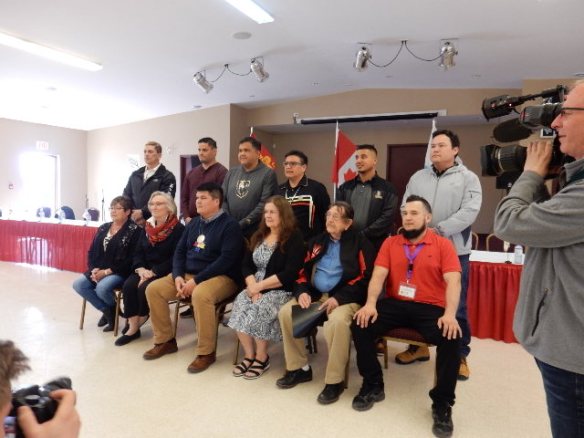
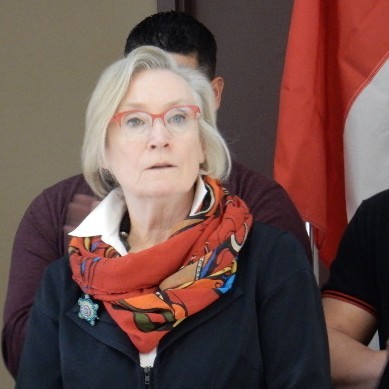


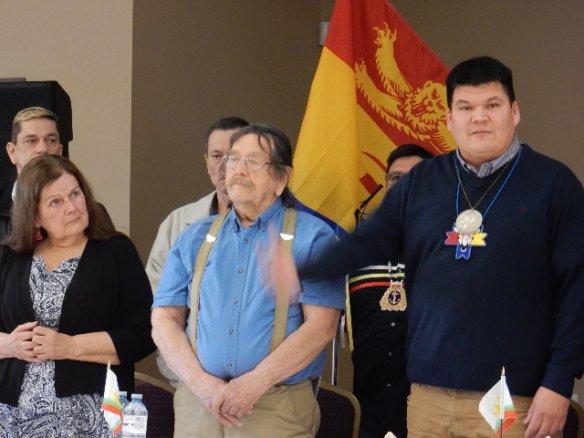


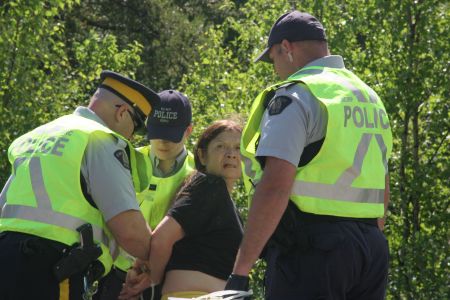
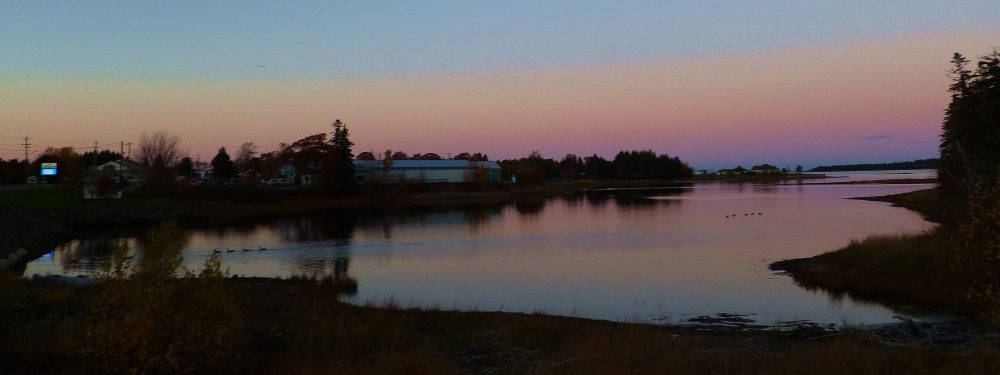







 rule of law” is bogus. The tired old argument about the “rule of law” surfaces whenever politicians and police act on behalf of corporations to repress peaceful dissent. Clearly, the “rule of law” was on the side of the Wet’suwet’en (SCC decisions, limitations of The Indian Act politicians, UNDRIP).
rule of law” is bogus. The tired old argument about the “rule of law” surfaces whenever politicians and police act on behalf of corporations to repress peaceful dissent. Clearly, the “rule of law” was on the side of the Wet’suwet’en (SCC decisions, limitations of The Indian Act politicians, UNDRIP).



 The observation was made that the RCMP are always in the middle of whatever brutal measures Canada is trying to force on Indigenous Peoples, and also have enough rotten apples in their own ranks that they are also mired in their own controversies about Indigenous Peoples. Cpl. Melanson assured us that the people he works with have good intentions and attitudes, but he said racism can crop up in any group. A community member said the RCMP must not allow themselves to be used in this way, and “to make your own definition of what is ethical behaviour.”
The observation was made that the RCMP are always in the middle of whatever brutal measures Canada is trying to force on Indigenous Peoples, and also have enough rotten apples in their own ranks that they are also mired in their own controversies about Indigenous Peoples. Cpl. Melanson assured us that the people he works with have good intentions and attitudes, but he said racism can crop up in any group. A community member said the RCMP must not allow themselves to be used in this way, and “to make your own definition of what is ethical behaviour.”











